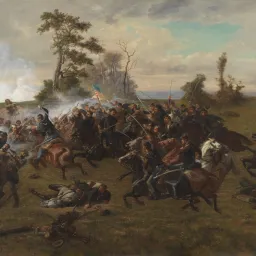1877 to 1924
Racial Inequality

Confederate defeat threatened to change white southern identity. Suddenly African Americans were free to determine the course of their lives, free to work for wages, and free to vote. To maintain the prewar social order, white Virginians segregated blacks from white society, denied them meaningful employment, and created a political system that by the end of the century so successfully negated their vote that Ku Klux Klan intimidation and oppression was little utilized in the state. Although black Virginians were no longer enslaved, equality remained an unfulfilled goal.
Development of a Black Middle Class
Former slaves were denied access to decent jobs and commercial services by segregation laws. This system of racial discrimination came to be known as “Jim Crow”––in reference to a stereotypical black character in minstrel shows. African Americans were compelled to establish parallel economies in order to find jobs and such basic services as grocery stores, banks, and hotels.
The Grand Fountain of the United Order of True Reformers
Former slaves helped one another through mutual-aid societies and fraternal organizations like the Grand Fountain of the United Order of True Reformers. It became the largest and most successful black business enterprise in the United States between 1881 and 1910. William Washington Browne, a former slave, founded it in Richmond. Members were offered banking, real estate, and retirement services, and a youth business division.
The Knights of Pythias
Unlike the True Reformers and the Order of St. Luke, which were mutual-aid societies, the Knights of Pythias was an African American secret fraternal order––similar to the Masons. Named for Pythias, an ancient Greek willing to sacrifice his life to save a friend, Pythians strove to copy that example of friendship and loyalty. They sold insurance that paid funeral expenses and provided death benefits and sick pay.
Maintaining the Old Social Order
Benevolent masters and contented slaves populate the mythic Old South projected by whites in popular songs, such as “Carry Me Back to Old Virginny” (1878), and in postwar literature, all of which served to invoke nostalgic memories of bygone days.
Many former slaves became Republicans and elected nearly one hundred African Americans to state office. Others joined with poor whites to form the Readjuster Party, which campaigned to readjust (lower) the state’s large pre–Civil War debt. The Readjusters won control of the state legislature. In 1881, they held the governorship and elected former Confederate general William Mahone to the U.S. Senate. But in 1885, white voters rejected both the Republicans and Readjusters in favor of the Democratic Party and initiated a century of government-sponsored racial discrimination.
The Ku Klux Klan
Ku Klux Klan violence in Virginia almost vanished after a few months of Reconstruction––because white leaders were able to establish supremacy by political means. Later, the Klan did initiate kidnappings, floggings, and at least one lynching. It was strongest in Virginia after World War I, when it added immigrants, Catholics, Jews, and organized labor to its list of “anti-American” groups.
Racial Identity
A cigar store figure with African American facial features and Native American dress (about 1880–90) evokes the history of enslaved African Americans who grew tobacco and the Indians who introduced it. It also reveals the stereotypes held by many whites of both as equally inferior. That perception allowed the Virginia General Assembly in 1924 to pass the Racial Integrity Act, which labeled both simply as “colored.” As state records were altered, Virginia Indians were stripped of their identity.
New Technology, Old Discrimination
Although electric streetcars were symbols of progress, they also became daily reminders of racial segregation. Initially riders were able to sit where they chose, but a 1906 law requiring African Americans to sit in the back led to a year-long boycott of the system. Though unsuccessful, the boycott signaled assertiveness among blacks willing to challenge Jim Crow laws.






















